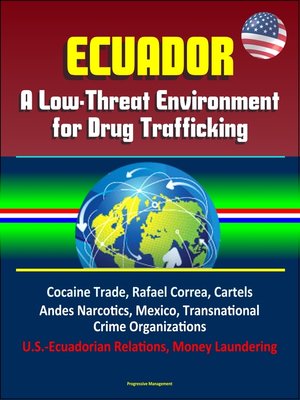Ecuador
ebook ∣ A Low-Threat Environment for Drug Trafficking--Cocaine Trade, Rafael Correa, Cartels, Andes Narcotics, Mexico, Transnational Crime Organizations, U.S.-Ecuadorian Relations, Money Laundering
By Progressive Management

Sign up to save your library
With an OverDrive account, you can save your favorite libraries for at-a-glance information about availability. Find out more about OverDrive accounts.
Find this title in Libby, the library reading app by OverDrive.



Search for a digital library with this title
Title found at these libraries:
| Loading... |
This excellent report has been professionally converted for accurate flowing-text e-book format reproduction. Ecuador's role in the cocaine trade has historically differed from its drug-trafficking neighbors. This Andean country traditionally serves as a transshipment hub for illegal narcotics, precursor chemicals, and a place to launder money. Over the past several years, however, Ecuador appears to have become a rising actor in the cocaine trade. Seizures are increasing and so is the presence of transnational criminal organizations. Why is Ecuador now experiencing an increase in cocaine seizures? What factors explain this emergence? What is attracting transnational criminal organizations, such as the Mexican cartels, the Russian Mafia, and the Chinese Triads, to Ecuador? Furthermore, how has Ecuadorian President Rafael Correa's administration, its policies, and its relationship with the United States contributed to this new dynamic? This study argues that the increased flow of cocaine through the country is what is driving the increase in seizures. This increase is further attributed to the ease of operating in Ecuador, making it a low-threat option for cocaine traffickers.
CHAPTER I - ECUADOR: A LOW-THREAT OPTION FOR COCAINE TRAFFICKING * A. INTRODUCTION * B. SIGNIFICANCE OF THE RESEARCH QUESTIONS * C. LITERATURE REVIEW * 1. Ecuador's Role in the Drug Trade * a. History of Cocaine in the Andes * b. Evolution of Narcotics Prohibition: The Andean Target * 2. Ecuador's Domestic Politics and Rafael Correa * D. U.S.-ECUADORIAN RELATIONS * E. POTENTIAL EXPLANATIONS AND HYPOTHESES * F. RESEARCH DESIGN * G. THESIS OVERVIEW * CHAPTER II - ECUADOR'S ROLE IN THE COCAINE SUPPLY CHAIN * A. INTRODUCTION * B. CURRENT TRENDS: COCAINE AND TRANSNATIONAL CRIMINAL ORGANIZATIONS * C. SHIFT FROM COLOMBIA TO MEXICO * D. THE SHIFT FROM MEXICO, SOUTH TO CENTRAL AMERICA AND THE ANDES * E. ECUADOR IN THE SUPPLY CHAIN: INTERNAL ROUTES * F. MARITIME TRAFFICKING * G. PRECURSOR CHEMICALS * CHAPTER III - ECUADOR'S DOMESTIC POLITICS AND RELATIONS WITH THE UNITED STATES * A. INTRODUCTION * B. A HISTORY OF POLITICAL CHAOS * C. RAFAEL CORREA'S "CITIZEN REVOLUTION" * D. DRUG POLICIES PRE-CORREA * E. DRUG POLICIES UNDER THE CORREA ADMINISTRATION * F. U.S.-ECUADORIAN RELATIONS: A DOWNWARD TREND * CHAPTER IV - EXPLAINING THE INCREASE IN COCAINE FLOW * A. INTRODUCTION * B. COMMON EXPLANATIONS * 1. Corruption * 2. Weak Institutions * a. The Judicial System * b. The Financial System * C. EXPLANATIONS SPECIFIC TO ECUADOR * 1. The New Drug Law Reforms and the Growth of Microtrafficking * 2. Reduced U.S. Counternarcotics Involvement * CHAPTER V - CONCLUSION AND RECOMMENDATIONS * A. CHAPTER SUMMARIES * 1. The Ecuadorian Drug Trade * 2. U.S.-Ecuadorian Relations * 3. Explanations and Findings * B. RECOMMENDATIONS * 1. Prioritize Rebuilding Trust and Influence in Ecuador * 2. Andean Region Intelligence Fusion Center






